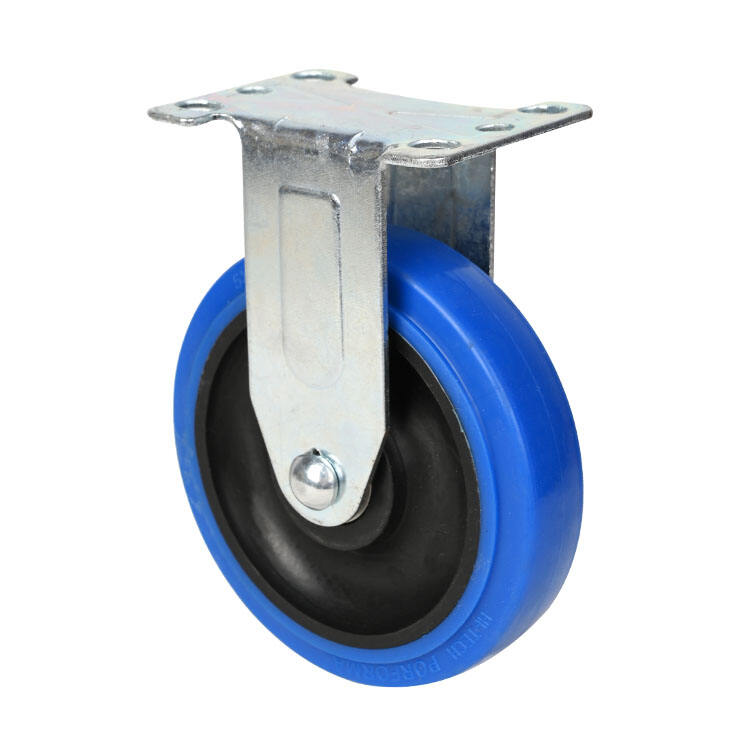Udhëzues Esencial për Mirëmbajtjen e Rrotave me Rrota PVC
Rrotave me rrota PVC janë pjesë thelbësore në numra të pangritshëm aplikimesh, nga mobiljet zyrtare deri te pajisjet industriale. Për qëndrueshmërinë, funksionimin e lehtë dhe efektivitetin në kushte kushtesh, ato janë një zgjedhje popullore në industritë e ndryshme. Megjithatë, si çdo pjesë mekanike, këto rrota kërkojnë mirëmbajtje të duhur për të siguruar performancë optimale dhe jetë të zgjatur. Ky udhëzues i hollësishëm do të zbulojë praktikat më të mira për mirëmbajtjen e rrotave me rrota PVC, duke ju ndihmuar t'i maksimalizoni qëndrueshmërinë dhe funksionalitetin.
Kuptimi i Përbërësve të Rrotave me Rrota PVC
Struktura Bërthamore dhe Materiat
Rrotat me PVC përbëhen nga disa komponente kyçe që funksionojnë së bashku. Rrota e jashtme është bërë prej kloruri të polivinilit (PVC), një material plastik sintetik të qëndrueshëm i njohur për rezistencën ndaj kimikateve dhe fërcimit. Bërthama e brendshme zakonisht ka çelik ose plastikë të gradës së lartë, duke ofruar integritet strukturor dhe kapacitet bartës ngarkese. Kuptimi i këtyre komponentëve është i rëndësishëm për mirëmbajtjen dhe kujdesin adekuat.
Sistemet e Rulmaneve dhe Montimi
Sistemi i rulmaneve është zemra e rrotave me PVC, i cili mundëson rrotullim të lehtë dhe lëvizje. Shumica e dizajneve përfshijnë rulmane sferike ose rulmane rrothi, të siguruar për të parandaluar infiltimin e copave të pluhurit. Plaka e montimit ose kaminja lidh grupin e rrotës me mobilen ose pajisjen, gjë që kërkon kontroll të rregullt për të ruajtur aligjnimin dhe sigurinë e duhur.
Procedurat e Mirëmbajtjes Regullore
Protokolle për Pastrim dhe Inspektim
Pastrimi i rregullt është themelore për ruajtjen e rrotave të PVC-së. Filloni duke hequr mbeturinat dhe pluhurin e dukshëm duke përdorur një furçë të butë ose një leckë. Për ndotësinë e fortë, përdorni një tretësirë me xham i cili nuk është shumë i fortë, duke kujdesur që të mos e lagështoni tepër lagështinë në bejringje. Kryeni kontroll vizual javor për të kontrolluar shenjat e konsumit, çarjet ose problemet e bejringjeve. Ky qasje parandalues i ndihmon të identifikohen problemet potenciale para se të eskalojnë në probleme të mëdha.
Kërkesat e lubrifikimit
Lubrifikimi i duhur është i domosdoshëm për funksionimin e lëmuar dhe zvogëlimin e konsumit të rrotave të PVC-së. Aplikoni një lubrifikant bazik të silikonit në zonat e bejringjeve çdo tre deri në gjashtë muaj, në varësi të intensitetit të përdorimit. Shmangni produktet bazike të naftës, pasi këto mund të dëmtojnë materialin e PVC-së. Kur bëhet lubrifikimi, rrotullojeni rrotën për të siguruar shpërndarjen e barabartë dhe fshini çdo tepër siç del për të parandaluar grumbullimin e pluhurit.
Kujtime për mjedisin
Menaxhimi i temperaturës
Rrotat me material PVC funksionojnë më mirë brenda diapazoneve të caktuar temperaturorë. Nxehtësia e tepërt mund të shkaktojë butësim dhe deformim, ndërsa temperaturat e ulëta mund të çojnë në thyeshmëri. Ruajeni pajisjen me rrota PVC në mjedise me klimë të kontrolluar, kur është e mundur. Nëse ekspozimi ndaj ekstremeve të temperaturës nuk mund të shmanghet, kryeni inspektime më të shpeshta dhe konsideroni masa mbrojtëse si mbulesa për rrota.
Ndikimet e Sipërfaqes dhe Të Ngarkuarit
Mjedisi i punës ndikon në mënyrë të konsiderueshme në jetëgjatësinë e rrotave PVC. Sipërfaqet e ruguara ose të paplota përshkojnë më shpejt sa vjen deri te konsumi, ndërsa ngarkesat e mëdha mund të shkaktojnë dështim të herëshëm. Sigurohuni që rrotat tuaja janë të vlerësuara në mënyrë të përshtatshme për përdorimin dhe kushtet e operimit për të cilat janë parashikuar. Konsideroni instalimin e mbrojtësve të dyllit ose tapishoreve në zonat me trafik të lartë për të minimizuar goditjet dhe për të zgjatur jetën e rrotave.

Strategjitë e kujdesit parandalues
Teknikat e Shpërndarjes së Ngarkesës
Shpërndarja e duhur e ngarkesës është e rëndësishme për parandalimin e konsumit të herëshëm dhe ruajtjen e performancës së rrotave me rrota PVC. Sigurohuni që peshët të shpërndahen në mënyrë të barabartë në të gjitha rrotat dhe shmangni tejkalimin e kufijve të peshës të specifikuar nga prodhuesi. Kur zhvendosni ngarkesa të rënda, shtyqini në vend që t'i tërhiqni, për të zvogëluar stresin mbi pjesët e rrotës. Kontrollimet dhe rregullimet periodike të peshës ndihmojnë në parandalimin e modeleve të papjerrta të konsumit.
Modelet e Lëvizjes dhe Përdorimi
Modele të vetëdijshme lëvizjeje mund të zgjatinë në mënyrë të konsiderueshme jetëgjatësinë e rrotave me rrota PVC. Shmangni ndryshimet e menjëhershme të drejtimit dhe lëvizjet e shpejta që i vënë stres rrotave dhe rulmaneve. Kur janë të palëvizshme për periudha të gjata, rrotullojini periodikisht rrotat për të parandaluar vende të rrafshëta dhe probleme me rulmanët. Zbatimi i udhëzimeve të duhura për përdorim ndihmon në ruajtjen e performancës optimale dhe jetëgjatësisë.
Programi i Mirëmbajtjes së Specializuar
Protokollet Periodike të Vlerësimit
Vendosni një orar të rregullt mirëmbajtjeje bazuar në intensitetin e përdorimit dhe kushtet mjedisore. Kryeni inspektime bazë mujore për konsumim të dukshëm, pastrime të plota tremujore dhe vlerësime gjithëpërfshirëse gjysmëvjetore të të gjithë komponentëve. Dokumentoni aktivitetet dhe vëzhgimet e mirëmbajtjes për të ndjekur modelet e konsumimit dhe për të parashikuar nevojat e zëvendësimit.
Udhëzime për Zëvendësimin
Edhe me mirëmbajtje të duhur, rrotat e PVC-së në fund të fundit kërkojnë zëvendësim. Shënimet që tregojnë nevojën për zëvendësim përfshijnë crack-e të dukshme, vende të sheshta, lëkundje e tepërt ose zhurmë nga rulmentët. Gjurmohuni moshën dhe historinë e përdorimit të rrotave tuaja për të parashikuar nevojën për zëvendësim. Duke pasur rrota rezervë në dorë siguron kohë minimale pushimi kur zëvendësimi bëhet i domosdoshëm.
Pyetje të Bëra Shpesh
Sa shpesh duhet të pastroj rrotat e mia të PVC-së?
Pastroja e rregullt duhet të kryhet javërisht për përdorim normal, me rekomandimin e një pastrimi të thellë njëherë në muaj. Mjediset me trafik të lartë ose të pluhur mund të kërkojnë pastrim më të shpeshtë për të ruajtur performancën optimale.
Cilat shenja tregojnë zëvendësim të menjëhershëm të rrotës së PVC-së?
Zëvendësoni menjëherë rrotat nëse vini re çarje, vende të dukshme të braktisura, bllokim të rulive ose lëkundje të tepërt gjatë funksionimit. Këto kushte mund të komprometojnë sigurinë dhe funksionimin e pajisjes.
A mund të përdor pastrues shtëpiak të zakonshëm në rrotat e PVC-së?
Është më mirë të shmangni pastrues kimikë të ashpër që mund të dëmtojnë materialin PVC. Përdorni zgjidhje me sapun të butë dhe pastrues të specializuar për rrota të dizajnuar për materiale sintetike. Gjithmonë testoni pastruesit në një zonë të vogël në fillim.

